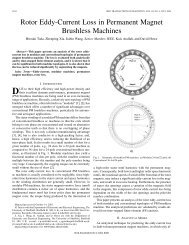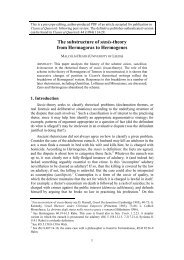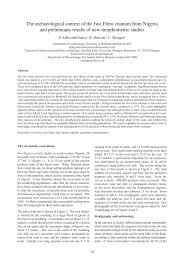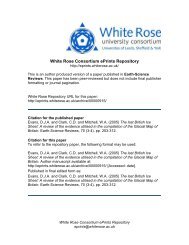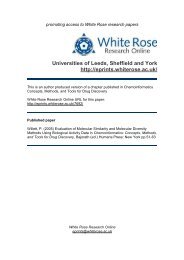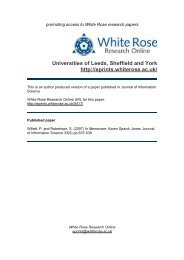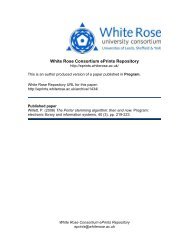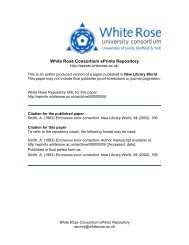The last British Ice Sheet: A review of the evidence utilised in the ...
The last British Ice Sheet: A review of the evidence utilised in the ...
The last British Ice Sheet: A review of the evidence utilised in the ...
You also want an ePaper? Increase the reach of your titles
YUMPU automatically turns print PDFs into web optimized ePapers that Google loves.
22,480±300 years BP from glacimar<strong>in</strong>e sediments deposited beyond <strong>the</strong> mora<strong>in</strong>al banks on <strong>the</strong> shelf south <strong>of</strong><br />
St Kilda provides a Late Devensian age for <strong>the</strong> glacier marg<strong>in</strong>. Fur<strong>the</strong>r dates from cores <strong>in</strong> <strong>the</strong> St Kilda bas<strong>in</strong><br />
<strong>in</strong>dicate that it was deglaciated sometime after 15.2 ka BP even though glacimar<strong>in</strong>e sedimentation cont<strong>in</strong>ued<br />
until after 13.5 ka BP (Peacock et al., 1992). <strong>The</strong> bracket<strong>in</strong>g <strong>of</strong> o<strong>the</strong>r major landform assemblages <strong>in</strong> Scotland<br />
has proved difficult <strong>in</strong> <strong>the</strong> absence <strong>of</strong> good chronostratigraphic control. An age bracket for <strong>the</strong> ice-marg<strong>in</strong>al<br />
landforms <strong>of</strong> <strong>the</strong> lower Dee Valley (Brown, 1993) is provided by a radiocarbon date <strong>of</strong> 12.6 ka BP on basal<br />
peat near Braemar and a m<strong>in</strong>imum age <strong>of</strong> 15,370 years BP for onshore recession <strong>of</strong> ice on <strong>the</strong> coast <strong>of</strong><br />
Aberdeenshire (Hall and Jarvis, 1989). <strong>The</strong> maximum age <strong>of</strong> <strong>the</strong> Ardersier Readvance <strong>in</strong> <strong>the</strong> Moray Firth<br />
(Merritt et al., 1995) is provided by <strong>the</strong> dat<strong>in</strong>g <strong>of</strong> <strong>the</strong> Errol Beds that were glacitectonized dur<strong>in</strong>g ice<br />
overrid<strong>in</strong>g. Gordon and Su<strong>the</strong>rland (1993) have bracketed <strong>the</strong> Errol Beds between 17 ka and 13 ka BP.<br />
Although an age bracket <strong>of</strong> 18 ka–13 ka BP was orig<strong>in</strong>ally proposed for <strong>the</strong> Wester Ross Readvance by<br />
Rob<strong>in</strong>son and Ballantyne (1979), more recent speculation has placed <strong>the</strong> age <strong>of</strong> <strong>the</strong> event at 13.5 ka–13 ka BP<br />
(Ballantyne et al., 1987; Ballantyne, 1993) at <strong>the</strong> time when <strong>the</strong> oceanic polar front migrated north <strong>of</strong> <strong>the</strong><br />
Scottish west coast (Ruddiman and McIntyre, 1973). A basal peat date <strong>of</strong> 12,810±155 years BP provides a<br />
m<strong>in</strong>imum age for <strong>the</strong> event (Kirk and Godw<strong>in</strong>, 1963).<br />
2.3.3. South central Scotland<br />
A deglacial date <strong>of</strong> 12,750±120 BP has been reported from <strong>the</strong> basal peat <strong>of</strong> a kettle hole <strong>in</strong> glacifluvial<br />
deposits that lie between Doune Lodge and <strong>the</strong> Loch Lomond Readvance at Callander (Lowe, 1978). This<br />
provides a m<strong>in</strong>imum date for <strong>the</strong> recession <strong>of</strong> <strong>the</strong> Teith glacier from <strong>the</strong> area. <strong>The</strong> deglaciation <strong>of</strong> <strong>the</strong><br />
Paisley-Renfrew area <strong>of</strong> <strong>the</strong> Glasgow region is reported to have been around 12.8 ka or slightly earlier<br />
accord<strong>in</strong>g to radiocarbon dates on mar<strong>in</strong>e shells <strong>in</strong> <strong>the</strong> local Clyde Beds (Peacock, 1971; Browne et al., 1977;<br />
Su<strong>the</strong>rland, 1986).<br />
2.3.4. Eastern England<br />
A variety <strong>of</strong> <strong>evidence</strong>, poorly constra<strong>in</strong>ed by absolute dat<strong>in</strong>g, has been used to propose limits <strong>of</strong> an early<br />
Devensian glacial advance and two later readvances on Holderness (see also section 2.2.3), where <strong>the</strong> North<br />
Sea lobe <strong>of</strong> <strong>the</strong> <strong>British</strong> <strong>Ice</strong> <strong>Sheet</strong> moved onshore. <strong>The</strong> westernmost limit <strong>of</strong> <strong>the</strong> drift on Holderness has<br />
traditionally been used as <strong>the</strong> limit <strong>of</strong> a Devensian glaciation and an early Devensian age has been supported<br />
for <strong>the</strong> relatively more subdued drifts west <strong>of</strong> <strong>the</strong> River Hull (e.g. Straw, 1979). As outl<strong>in</strong>ed above, <strong>the</strong><br />
readvances <strong>of</strong> Holderness and <strong>the</strong> east end <strong>of</strong> <strong>the</strong> Vale <strong>of</strong> Picker<strong>in</strong>g have not been recognized by more recent<br />
researchers, because <strong>the</strong> limits were based largely upon <strong>the</strong> nebulous criteria <strong>of</strong> mora<strong>in</strong>e freshness and lacked<br />
chronostratigraphic control. Moreover, <strong>the</strong> smoo<strong>the</strong>r topography <strong>of</strong> <strong>the</strong> tills <strong>in</strong> west Holderness is a result <strong>of</strong><br />
Holocene flood<strong>in</strong>g and drap<strong>in</strong>g <strong>of</strong> lower altitude hummocks ra<strong>the</strong>r than an age difference to <strong>the</strong> slightly more<br />
hummocky drift east <strong>of</strong> <strong>the</strong> River Hull. <strong>The</strong> westernmost limits <strong>of</strong> <strong>the</strong> North Sea ice <strong>in</strong> Holderness dur<strong>in</strong>g <strong>the</strong><br />
44




